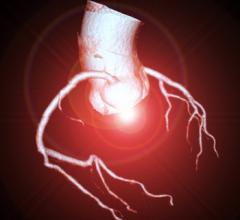
A cardiac CT showing a severe right coronary artery lesion on both 3-D and curved multiplanar reconstructions from a Toshiba Aquilion One CT system. The newest generation of CT scanners have very fast gantry speeds to freeze cardiac motion, improved image quality and much lower doses than previous generation scanners from a decade ago.
Cardiac computed tomography (CT) imaging really took off a decade ago with the introduction of 64-slice scanners, which today is the standard for most CT imaging. Many hospitals are now looking to replace their older 64-slice systems with newer technology, which may offer an even bigger boom in cardiac CT usage.
The newest generation of scanners marketed for cardiac exams can perform routine, very-low-dose cardiac scans of 3 mSv or less. They use more sensitive detectors, faster gantry speed rotation, and the latest generation of iterative and model-based image reconstruction software. These technologies combine to enable low dose scans to be made at diagnostic quality at dose levels that would not have been possible just a few years ago. These technologies are the industry’s response to years of criticism by physicians and the general public over the high X-ray doses previously needed for cardiac CT scanning.
“Cardiac CT is really on the precipice and is really starting to accelerate in growth,” said Leslee Shaw, Ph.D., FACC, FASNC, FAHA, co-director of the Emory Clinical Cardiovascular Research Institute and president of the Society of Cardiovascular Computed Tomography (SCCT). “If you blink your eyes, you have missed several very prominent, randomized trials that support the utility of cardiac CT. We have more than just the pretty picture, we have seen dramatic growth in the technical aspects of CT with better image quality, better resolution, and we can go on and on.”
She said several trials now show cardiac CT offers a timely and efficient diagnosis of coronary disease, especially in the emergency room for chest pain patients who are considered low risk. While there are upticks in cardiac CT usage, Shaw explained there is still a lot of work needed on the reimbursement side. However, in today’s healthcare reform environment driven by clinical evidence and cost-benefit analysis, Shaw and other thought leaders from SCCT say the large amount of data being amassed from trials will eventually tip the scales. These trials have shown a steady stream of data illustrating cardiac CT angiography (CCTA or CTA) is more cost effective, faster and more efficient than the current standard of care.
“It can at times save money, but importantly for the patient, it can save them time and lead to an early discharge much more effectively and efficiently than anything else,” Shaw said. “In four stable ischemic heart disease randomized trials, CT is equally as effective as stress nuclear and stress echo and not more costly.”
Shaw said new technologies such as fractional flow reserve (FFR)-CT, coronary plaque assessment and CT perfusion imaging take CT beyond anatomic assessment to now allow physiologic assessment without the need for nuclear perfusion scans or invasive diagnostic angiography.
Shaw said coronary plaque assessment can be laborious to do manually, but as advanced visualization software becomes more automated, she believes it will see greater usage. Ideally, she said in an invasive exam in the cath lab, an FFR is performed and intravascular ultrasound imaging is used to assess lesions. But, she said CT offers a noninvasive way to perform these same assessments.
“I’m not sure to what extent we can become an intravascular imaging tool like what interventional cardiologists have access to, but I think we can quantify plaque volume, and that is really important for assessing patient risk,” Shaw said.
FFR-CT is U.S. Food and Drug Administration (FDA)-approved for the noninvasive hemodynamic assessment of the entire coronary tree. It creates a 3-D model of the patient’s coronary arteries and color-codes them based of computational fluid dynamics to show areas of low flow due to coronary lesions. This can help identify culprit lesions causing ischemic chest pain or a heart attack. The technology currently takes several hours to return a result, but as that processing time is reduced, FFR-CT is widely expected to see increased usage in the coming years.
CT as a Prevention and Risk Assessment Tool
From a prevention standpoint, Shaw believes CT has a good potential for serial imaging, using newer scanners that offer very low-dose scanning around 1 mSv or less of radiation dose. For this, she said there is a need to update older 64-slice systems to newer scanners with more sensitive detectors and newer versions of iterative and model-based image reconstruction software.
“One key take-home message is that no other modality will identify early coronary disease,” Shaw said. “Stress testing does not pick it up, because you will not elicit ischemia until you already have a good amount of coronary disease. But, with coronary CT we can identify that early plaque and that can really put a patient on a different course in terms of prevention.”
One area where cardiac CT as a risk assessment tool is already seeing growth is with calcium scoring. Numerous clinical trials have shown correlation between the amount of calcified plaque in coronary vessels and the risk that patient has for a heart attack. Shaw and other experts who spoke at SCCT said CT calcium scoring also could be used to help convince patients to go on statin therapy.
A recent Texas bill allows for calcium scoring to be performed every five years. “We are now seeing high rates of growth in CT usage there,” Shaw said.
Read the article “CT Calcium Scoring for Heart Disease May Lead to Prevention, Treatments.”
New Areas of Cardiac CT Usage
Shaw said one argument to upgrade older scanners is the need for precision imaging for new applications of cardiac CT, such as structural heart evaluation and procedural planning. She explained the need for precise imaging and CT advanced visualization software for areas such as transcatheter aortic valve replacement (TAVR), transcatheter mitral repair and left atrial appendage (LAA) occlusion can be used to make for a great business case. Even if a center has newer technology, they need to put a plan in place for how they can leverage that technology to bring them to a level of state-of-the-art cardiac imaging, Shaw said.
New CT Scanner Technology
The biggest advances in CT scanners over the past few years have been the introduction of new dose-lowering technologies, easily upgradeable scanners to allow conversion to high-slice systems, and faster gantry speeds to freeze cardiac motion. Additionally, the concept of slices a scanner can image at once is less important today than the total anatomical coverage the scanner can image in one rotation. An issue with 64-slice scanners was that it usually took two rotations to image the heart, with the two images being stitched together, which can lead to stitching artifacts. Scanners with wider anatomical coverage capable of imaging the heart on one rotation without the need for stitching are ideal for CTA. All the major CT vendors — GE, Hitachi, Philips, Siemens and Toshiba — have introduced new CT systems in recent years with enhanced cardiac scanning capability.
Shaw said new scanner technology should lower CT cardiac exams to 3 mSv or below. Some centers are already performing routine cardiac CT exams 1 mSv or below using the newest scanners and image reconstruction software. “There is a lot of concern out there about the overuse of CT and the radiation dose from CT, and having a new scanner with lower dose can be used as a marketing piece for hospitals,” Shaw suggested.
Detector resolution is another area of research to increase the image sharpness, especially to better define smaller structures like plaque composition and stents inside coronary vessels. Toshiba is currently testing a new scanner with a resolution of 0.2 mm.
In February 2016, GE Healthcare received FDA 510(k) clearance for the GSI Xtream technology on its Revolution CT. This is the first volume spectral CT technology designed to improve small lesion detection, tissue characterization and metal artifact reduction, with a simplified workflow.
GE also recently introduced its Whisper Drive technology, which is designed to take high-speed scans that allow full imaging of the heart in one heartbeat. This is accomplished using a high-speed X-ray tube, weighing about 100 pounds, that routinely reaches 70 Gs as it circles around the patient up to five times per second. This high speed is combined with intelligent motion correction. The gantry is constructed from aerospace-grade aluminum and includes a system of springs that absorb the acceleration, preventing movement of parts like the electronic board inside the detector. It uses contactless transmission to send power to the machine and collect the imaging signal from it. Older CT scanners use brushes to transmit power, but increasing the speed led to wear and reliability issues, according to the company.
At the Radiological Society of North America (RSNA) 2016 meeting last November, Toshiba unveiled the Aquilion One/Genesis. The compact CT platform ultimately will accommodate a family of upgradable scanners in the space occupied today by 64-slice scanners. The Genesis provides improved spatial resolution and faster slice reconstruction, as well as reduced radiation dose to the patient. To achieve these, the company redesigned not only its area detector and supporting components, but built into this infrastructure what the company describes as the world’s first model-based iterative reconstruction for volumetric CT. A 30-degree bidirectional gantry tilt capability enables angled scanning to avoid dosing radiosensitive organs.
Toshiba also released in April 2017 the compact and economical Aquilion Lightning 80 system. The 80-detector row (160-slice) system is designed for full body imaging and routine volumetric scanning with the premium CT technology found on high-end systems so that providers can deliver a better patient experience. It delivers fast reconstruction speeds of up to 50 images per second at full resolution, and it optimizes workflow and patient comfort with thin slices at 0.5 mm and a 78-cm bore. It also utilizes Single Energy Metal Artifact Reduction (SEMAR) and SURESubtraction. It can be reconfigured from 40 to 80 to 160 slices without replacing hardware.
Siemens Healthineers recently announced the first facility in the United States installed the company’s Somatom Drive system. The new high-performance scanner joins the Somatom Force and Somatom Definition Flash in the dual-source segment of the company’s CT portfolio. It was designed to drive precision in diagnostic imaging across clinical disciplines, including cardiology.
The Drive’s new Straton MX Sigma X-ray tube voltages are adjustable in 10 kV increments ranging from 70 kV to 140 kV, allowing clinicians to tailor the voltage and, therefore, the dose to each patient. It also offers extremely fast scanning speeds that support sedation-free pediatric exams and to freeze cardiac motion. The company claims cardiac imaging can be done in one heartbeat without the need for beta-blockers in some patients.
To learn more about some of the recent CT advances, watch the VIDEO "Editor’s Choice of Most Innovative New Technologies at RSNA 2016."
Comparison Chart of Cardiac CT Systems
This article served as an introduction for a cardiovascular CT system comparison chart in the May-June 2017 print issue of DAIC. To access the chart, go to www.dicardiology.com/content/cardiac-ct-systems. This will require a login, but it is free and only takes a moment to complete the form. This also will grant access to more than 40 other comparison charts.
Vendors in this chart include:
GE Healthcare, Philips Healthcare, Siemens Healthineers and Toshiba.




 December 11, 2025
December 11, 2025 









